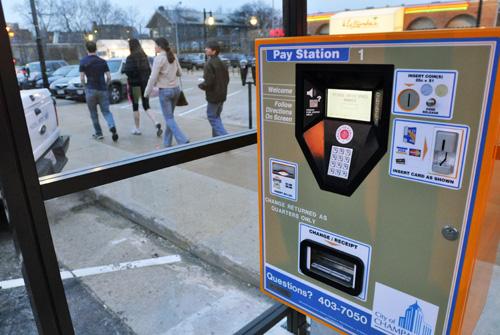Parking problems remain

The parking lot at Sixth and Healey streets in Champaign has a new pay system. Erica Magda
April 9, 2008
When students describe the parking situation on campus, and their assertions may reflect some version of Jonathan Niemerg’s frustrated response, it’s a pain.
“Spots are never available,” said Niemerg, sophomore in LAS, who has given up parking on campus. “I have a car, but I just walk everywhere.”
There are 15,000 parking spaces available to the 50,000 people on campus each day, according to the University of Illinois Parking Department Web site. The spaces are found in five parking structures and 123 surface parking lots on campus, a reduction from the 147 spots that were once in use.
Parking in the University Lot J on the corner of Sixth and Green streets had been free since 2006, but Champaign public works staff recently installed a new pay station.
It now costs 75 cents to park for the first two hours, and $1.50 for each subsequent hour.
Get The Daily Illini in your inbox!
“I’d be happy with increasing the number of spots,” said Niemerg. “More meters and more permit parking.”
Tom Skaggs, University parking and traffic coordinator, said that the rates on University meters have not been raised in 10 years.
“In the past six years our system has added two new parking decks to assist with parking needs,” Skaggs said in an e-mail.
“In addition, the Master Plan provides for added facilities, especially around the campus perimeter where shuttle services can assist with commuters and people moving on campus.”
Surface parking on campus has decreased during the last two years, however, because of the influx of new academic buildings.
There are not many places to site a new building other than on old parking lots, Skaggs said.
While students and University workers may gripe, there may be some advantages to the area overall.
The city’s policy is good for campus and city parking because it rewards short-term parkers and increases parking turnover, said At-Large Champaign City Council member Tom Bruno.
“But you can’t just suggest that to people,” Bruno said. “You have to charge them for it to work.”
Bruno said that increased parking is something that everyone in the city wishes for.
But he said it is also something that is becoming less of a possibility due to expansion and increasing density in the city as buildings go up, eliminating the amount of space available for parking.
“It’s hugely expensive to build new areas for parking, and it’s an adjustment for the community to deal with that,” Bruno said.
“We’re building a 600-car parking garage downtown in conjunction with a new office building, and it will cost about $12 million.”
Bruno said the city’s parking ordinances are actually meant to discourage people who work in Campustown or at the University to bring their cars to work.
The main idea, he said, is the more people have to pay for parking, the less they will want to park and the more spaces will remain open.
However, he said the Council receives complaints from parkers who are inconvenienced by this policy.
“Usually my parents complain when I send them to park in Lot E-14, past Assembly Hall,” said Logan Gilbertsen, sophomore in Engineering.
However, there is an alternative to parking for those who live a short distance away from the University campus, they can still walk.






